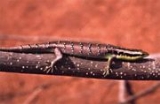
Dasia haliana
Encyclopedia
Tree Skink Dasia haliana is a species of tree skink found in the southern Western Ghats
and Sri Lanka.
Like other reptiles their taxonomic
identification is based on scalation
. They have a pointed snout and the distance of the nostril to tip is longer than the diameter of the eye. The scales above the nostril are not in contact with each other and the fronto-nasal scale is equal in width and length. The prefrontals are large and are separated from another narrow frontal. The interparietal scale is variable in size and when large separates the parietals. There are a pair of nuchal (nape) scales, four scales above the eye with the second being largest and the first and second in contact with the frontal. There are 7 or 8 supraciliaries, with the first being longer than the others. There are two loreals which are longer than their height. The temporal scales are larger than the scales on the sides of the neck. The tympanum
of the ear is sunken and is less than a fourth of the diameter of the eye.
The dorsal scales have 3 or 5 blunt keels, two vertebral rows of scales are wider than the rest. The tail tapers to a point and is as long as the head and body. The limbs are short, the toes are long with 17 or 18 lamellae (or plate like scales) beneath the fourth toe. The palms and soles have flat tubercles with larger ones on the heel, especially in the male.
The colouration is yellowish-olive above, with broad black bands which are as wide as the space between them. There are 5 or 6 of these bands on the neck and body with a black mark on the occiput extending forward as streaks on top of the head. There are two lateral stripes passing through the eye and nostril. The underside is yellow.
Western Ghats
The Western Ghats, Western Ghauts or the Sahyādri is a mountain range along the western side of India. It runs north to south along the western edge of the Deccan Plateau, and separates the plateau from a narrow coastal plain along the Arabian Sea. The Western Ghats block rainfall to the Deccan...
and Sri Lanka.
Description
This arboreal skink, about 8 cm long, in the genus Dasia is distinct from all other sister species in having a smaller number of scale rows at the mid-body (22-24) and an enlarged set of vertebral row scales.Like other reptiles their taxonomic
Taxonomy
Taxonomy is the science of identifying and naming species, and arranging them into a classification. The field of taxonomy, sometimes referred to as "biological taxonomy", revolves around the description and use of taxonomic units, known as taxa...
identification is based on scalation
Snake scales
Snakes, like other reptiles, have a skin covered in scales. Snakes are entirely covered with scales or scutes of various shapes and sizes. Scales protect the body of the snake, aid it in locomotion, allow moisture to be retained within, alter the surface characteristics such as roughness to aid in...
. They have a pointed snout and the distance of the nostril to tip is longer than the diameter of the eye. The scales above the nostril are not in contact with each other and the fronto-nasal scale is equal in width and length. The prefrontals are large and are separated from another narrow frontal. The interparietal scale is variable in size and when large separates the parietals. There are a pair of nuchal (nape) scales, four scales above the eye with the second being largest and the first and second in contact with the frontal. There are 7 or 8 supraciliaries, with the first being longer than the others. There are two loreals which are longer than their height. The temporal scales are larger than the scales on the sides of the neck. The tympanum
Eardrum
The eardrum, or tympanic membrane, is a thin membrane that separates the external ear from the middle ear in humans and other tetrapods. Its function is to transmit sound from the air to the ossicles inside the middle ear. The malleus bone bridges the gap between the eardrum and the other ossicles...
of the ear is sunken and is less than a fourth of the diameter of the eye.
The dorsal scales have 3 or 5 blunt keels, two vertebral rows of scales are wider than the rest. The tail tapers to a point and is as long as the head and body. The limbs are short, the toes are long with 17 or 18 lamellae (or plate like scales) beneath the fourth toe. The palms and soles have flat tubercles with larger ones on the heel, especially in the male.
The colouration is yellowish-olive above, with broad black bands which are as wide as the space between them. There are 5 or 6 of these bands on the neck and body with a black mark on the occiput extending forward as streaks on top of the head. There are two lateral stripes passing through the eye and nostril. The underside is yellow.
Other sources
- Annandale, Nelson 1906 New and interesting lizards in the Colombo Museum. Spol. Zeyl. 3: 189-192
- Deraniyagala,P.E.P. 1931 Some Ceylon Lizards. Ceylon J. Sci. B, 16: 139-180
- Greer, Allen Eddy, Jr. 1970 The Relationships of the Skinks Referred to the Genus Dasia. Breviora 348:1-30
- Joshua J; Sekar A G 1985 Range extension of the skink Dasia haliana (H. Nevill, 1887). J. Bombay Nat. Hist. Soc. 82 (2): 422-423
- Karthikeyan S 1991 Sighting of the arboreal skink Dasia haliana at Mundanthurai Wildlife Sanctuary, Tamil Nadu. J. Bombay Nat. Hist. Soc. 88 (1): 122-123

